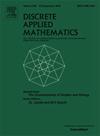Double Roman domination stability in graphs
IF 1
3区 数学
Q3 MATHEMATICS, APPLIED
引用次数: 0
Abstract
A double Roman dominating function (DRDF) on a graph is a function having the property that if , then the vertex must have at least two neighbors assigned 2 under or one neighbor with , and if , then the vertex must have at least one neighbor with . The weight of a DRDF is the sum of its function values over all vertices, and the double Roman domination number is the minimum weight of a DRDF on . The -stability (-stability, -stability) of , denoted by
(, ), is defined as the minimum size of a set of vertices whose removal changes (decreases, increases) the double Roman domination number. In this paper, we determine the exact values on the -stability of some special classes of graphs, and present some bounds on . In addition, for a tree with maximum degree , we show that and , and characterize the trees that achieve the upper bound.
双罗马统治稳定的图形
图G上的双罗马支配函数(DRDF)是一个函数f:V→{0,1,2,3},它具有这样的性质:当f(V)=0时,顶点V必须有至少两个赋值为2的邻居,当一个邻居w =3时,如果f(V)=1,则顶点V必须有至少一个赋值为2的邻居w,且f(w)≥2。DRDF的权值是它在所有顶点上的函数值的和,双罗马支配数γdR(G)是DRDF在G上的最小权值。G的γdR-稳定性(γdR -稳定性,γdR+稳定性),用stγdR(G) (stγdR - (G), stγdR+(G))表示,定义为一组顶点的最小大小,这些顶点的移除改变(减少,增加)双罗马支配数。本文给出了一类特殊图的γ - dr -稳定性的精确值,并给出了一类特殊图的st - γ - dr (G)的界。此外,对于最大度为Δ的树T,我们证明了stγdR(T)=1和stγdR−(T)≤Δ,并对达到上界的树进行了表征。
本文章由计算机程序翻译,如有差异,请以英文原文为准。
求助全文
约1分钟内获得全文
求助全文
来源期刊

Discrete Applied Mathematics
数学-应用数学
CiteScore
2.30
自引率
9.10%
发文量
422
审稿时长
4.5 months
期刊介绍:
The aim of Discrete Applied Mathematics is to bring together research papers in different areas of algorithmic and applicable discrete mathematics as well as applications of combinatorial mathematics to informatics and various areas of science and technology. Contributions presented to the journal can be research papers, short notes, surveys, and possibly research problems. The "Communications" section will be devoted to the fastest possible publication of recent research results that are checked and recommended for publication by a member of the Editorial Board. The journal will also publish a limited number of book announcements as well as proceedings of conferences. These proceedings will be fully refereed and adhere to the normal standards of the journal.
Potential authors are advised to view the journal and the open calls-for-papers of special issues before submitting their manuscripts. Only high-quality, original work that is within the scope of the journal or the targeted special issue will be considered.
 求助内容:
求助内容: 应助结果提醒方式:
应助结果提醒方式:


